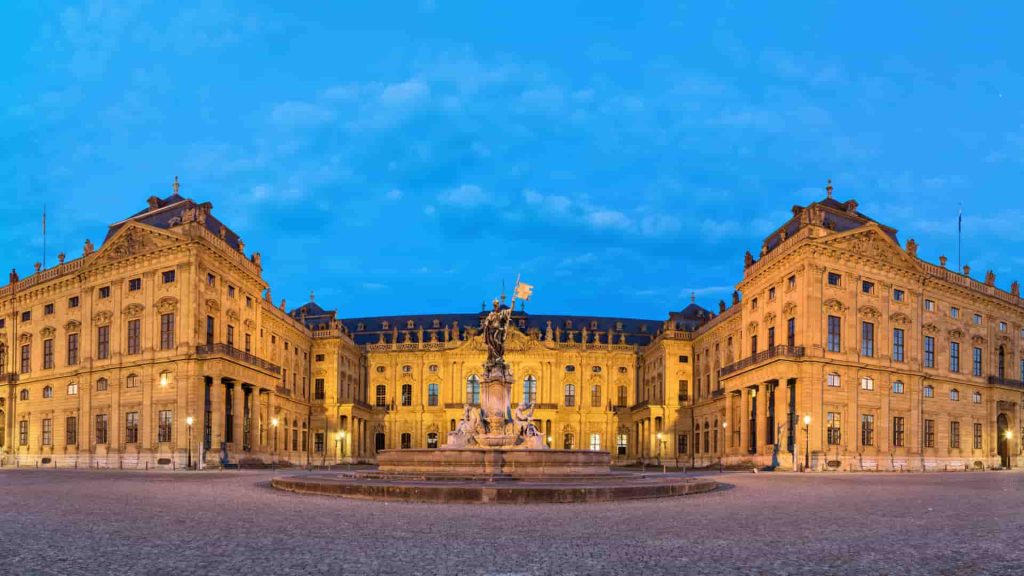
Germany’s history is alive, and it beckons from the cobblestones of Trier to the spires of Cologne Cathedral. Stand beneath Trier’s Porta Nigra, the largest Roman gate north of the Alps, and feel the echoes of 180 AD resonating through the stone archway that once thrummed with ancient life. It’s not just an entrance but a portal to a world teeming with stories from millennia past.
Not inspired to star in your gothic novel?
Look down here, then!
Shift your gaze to the Cologne Cathedral, where each of its 632 years of construction layers into a magnificent Gothic crescendo. This isn’t merely a building; it’s a vault of human endeavor, housing marvels like the medieval stained glass windows and the gilded Shrine of the Three Kings. Here, every crevice and corner is a fingerprint of history.
In Germany, history doesn’t whisper; it speaks volumes. Prepare to step into a narrative stitched across time, told not through pages, but through the very paths you’ll tread and the structures that rise to greet you.
Your recommended post for the week: Struggling to Make a Budget for Your Move to Germany? Here’s Our Detailed 7-Step Plan
6 Must-Visit Historical Sites in Germany in 2024
Germany is home to several cultural insights and legends. Several events in history that have changed the trajectory of humanity has either began here or have a central focus in Germany. Keeping the same in mind, we have listed out our favourite historical sites you need to visit.
#1 Brandenburg Gate, Berlin
The Brandenburg Gate stands as a resilient icon, encapsulating Berlin’s tumultuous journey from triumph to division and ultimately unity. Commissioned by Frederick William II in the late 18th century, it celebrated Prussian victories with a design inspired by the Athenian Propylaea, symbolizing a quest for peace and enlightenment.
Yet, as wars scarred its façade, the Gate bore witness to history’s darkest hours, enduring damage in World War II and becoming a poignant symbol of division during the Cold War.
As the Berlin Wall fell in 1989, the Gate transformed from a silent sentinel of a divided city to a jubilant beacon of unity and hope. Adorning its summit, Victoria, the Roman goddess of victory, drives her chariot, once stolen by Napoleon but triumphantly reclaimed, symbolizing resilience and victory.

Visiting Insights
Best Time to Visit: Embrace the Gate’s grandeur at dawn or dusk for a quieter, more atmospheric experience. The soft light accentuates its architectural nuances and the stirring history it embodies.
Hidden Gems: Explore the surrounding Pariser Platz for a holistic experience. Delve into nearby museums or relax in the Tiergarten, allowing the Gate’s presence to permeate your visit from various perspectives. Keep an eye out for the remaining foundations of the tollhouse and imagine the carriages that once passed through this historic threshold.
Don’t forget to read: Understanding the Nuances of Student Accommodation in Berlin
#2 Neuschwanstein Castle, Bavaria
Neuschwanstein Castle emerges from the Bavarian Alps like a dream woven from the mist, embodying King Ludwig II’s fantastical vision. Dubbed the “Mad King,” Ludwig poured his eccentric soul, inspired by medieval legends and Wagnerian operas, into creating this ethereal retreat.
Its spires and turrets leap from the rugged cliffs as if plucked from a storybook, a tribute to the king’s adoration of the romantic past and mythical grandeur.
Initiated in 1869, the castle’s construction spanned 17 years, with Ludwig’s untimely and mysterious death occurring just weeks after he took residence. Despite its unfinished state, the castle’s majesty is undeniable, from its soaring throne room to the artificial grotto complete with stalactites and a waterfall, a personal haven reflecting Ludwig’s imaginative spirit.
Today, Neuschwanstein’s silhouette doesn’t just dominate the Alpine horizon; it reigns in the hearts of dreamers worldwide, even inspiring Disneyland’s Sleeping Beauty Castle.

Visiting Insights
Best Time to Visit: Late spring or early autumn offers pleasant weather and thinner crowds. Capture the castle’s beauty amidst blooming or autumnal landscapes.
Surrounding Attractions: After marveling at the castle’s interior, wander the nearby trails for breathtaking views of the Alps and the castle. Don’t miss the Marienbrücke bridge for the iconic panorama of Neuschwanstein, and explore the charming town of Füssen, a treasure trove of Bavarian culture just a stone’s throw away.
We think you’ll love this: From Student Visa to Permanent Residency in Germany: 5 Important Yet Overlooked Nitty-Gritties to Keep in Mind
#3 Cologne Cathedral, Cologne
Cologne Cathedral, a masterpiece of Gothic architecture, stands as a monumental beacon of faith and history. As the tallest twin-spired church in the world, it pierces the Cologne skyline at an awe-inspiring 157 meters.
These spires, once the tallest structures globally, epitomize human ambition and spiritual devotion. The cathedral’s vast interior, capable of welcoming 20,000 souls, resonates with centuries of prayers and songs, its acoustics as impressive as its spiritual aura.
The cathedral’s foundations were laid in 1248, yet it reached completion only in 1880, witnessing generations of craftsmen dedicating their lives to its creation.
Its endurance is legendary, having survived 14 bombings during World War II, a testament to both divine providence and human foresight in preserving its medieval stained glass windows and sacred relics.

Visiting Insights
Best Time to Visit: Early morning or late afternoon avoids the peak tourist hours, allowing a more tranquil and reflective experience. The light filtering through the stained glass at these times adds a mystical aura.
Exploring Tips: Take time to absorb the details, from the soaring nave to the intricate stone carvings. Consider a guided tour to uncover the hidden stories and ascend the south tower for a panoramic view of Cologne. The surrounding area, with its historical sites and cultural offerings, is worth exploring post-visit.
#4 The Roman Monuments, Cathedral of St. Peter and Church of Our Lady in Trier
Trier, Germany’s oldest city, is a treasure trove of ancient Roman history, with the Cathedral of St. Peter and the Church of Our Lady standing as monumental testaments to its enduring legacy.
The Cathedral of St. Peter, the oldest in Germany, traces its origins back to the 4th century. It is a stunning mosaic of architectural styles, with Romanesque roots and Gothic embellishments, housing relics like the tomb of St. Helena, mother to Emperor Constantine.
Its interior is a dance of light through medieval stained glass, with sculptures and a richly decorated altar narrating tales of faith and artistry.
Nearby, the Church of Our Lady, an early Gothic marvel completed in 1270, echoes with the same depth of historical sites. Its delicate stonework and towering nave illustrate the architectural evolution, while the Holy Tunic, believed to have been worn by the Virgin Mary, bestows a profound spiritual significance, drawing pilgrims worldwide.

Visiting Insights
Best Time to Visit: Visit during the quieter spring or autumn months to fully appreciate the serene spiritual atmosphere and architectural beauty without the crowds.
Must-See Highlights: In the Cathedral, seek out the intricate altar and stained glass windows. In the Church of Our Lady, marvel at the Holy Tunic and the soaring nave’s architectural elegance. Don’t miss the chance to explore the surrounding Roman ruins, including the famed Porta Nigra, to fully immerse in Trier’s ancient past.
Also read: You Won’t Believe How Germany’s Liability Insurance System Operates!
#5 Heidelberg Castle, Heidelberg
Heidelberg Castle, a romantic emblem set against the Neckar River’s verdant banks, is a beautiful chronicle of architectural evolution and historical drama. From its 13th-century foundations to its final touches in the 17th century, the castle embodies a seamless blend of Gothic and Renaissance styles, visible in its majestic towers, delicate ornamentations, and grand courtyards.
Yet, this historical sites’ beauty is touched by a history of turmoil, surviving the ravages of the Thirty Years’ War and nature’s fury, standing today as a poignant ruin that captivates the imagination.
Among its many marvels, the Ottheinrichsbau flaunts Renaissance splendor, and the Hortus Palatinus unfurls as a verdant Renaissance garden, offering sweeping views of Heidelberg.

Visiting Insights
Best Time to Visit: Late spring to early fall offers mild weather and lush scenery. Visit early morning or late afternoon to avoid crowds and catch the golden light accentuating the ruins’ romantic allure.
Highlights to Explore: Traverse the grand courtyards, linger in the Hortus Palatinus for panoramic city views, marvel at the grandeur of the Ottheinrichsbau, and don’t miss the world’s largest wine barrel. Take a guided tour to uncover the castle’s layered history and enjoy a stroll down to Heidelberg’s old town for a day steeped in history and beauty.
#6 The Residenz, Würzburg
The Residenz in Würzburg is a testament to Baroque splendor, standing majestically as Germany’s largest palace of the era.
With three expansive wings encircling a grand courtyard, the palace unfolds over 170 rooms, each dripping with opulent decor and elaborate details. Its architectural grandeur and intricate artistry offer a journey through a realm of extravagance and beauty.
At the heart of the Residenz is the Octagon, an oval-shaped hall crowned with a magnificent fresco by Venetian master Giambattista Tiepolo. Known as the “Allegory of the Olympian Gods,” this celestial masterpiece is revered as one of the world’s most exquisite ceiling paintings, enveloping visitors in a divine spectacle of myth and grandeur.

Visiting Insights
Best Time to Visit: Late spring or early autumn offers comfortable weather and fewer tourists, allowing a more intimate experience of the Residenz’s lavish interiors.
Must-See Highlights: Ascend the renowned staircase to gaze upon Tiepolo’s frescoed masterpiece in the Octagon. Wander the extensive complex to admire the intricate decorations of each room, and don’t miss the opportunity to stroll through the adjoining court gardens, a serene retreat echoing the palace’s elegance.
Make sure to read: 5 Incredible Tips For Your Study Abroad in Germany to Make it a Transformative Experience!
Your Tour of the German Must-See Historical Sites Await…
And there you have it—a tapestry of towering spires, echoing halls, and whispering ruins, each with a story to tell.
You’ve wandered through gothic cathedrals, gazed upon fairy-tale castles, and strolled the opulent halls of palatial splendor. These six historical sites aren’t just stones and mortar; they’re the beating heart of Germany, pulsating with centuries of triumph, tragedy, and tales waiting to be told.
So, pack your curiosity, lace up your walking shoes, and set forth on a journey where history leaps from the pages and into your path.
Who knows what secrets you’ll uncover or what inspiration you’ll find? Germany’s historical gems are not just to be visited but to be experienced, felt, and remembered.
Ready for your next adventure?




